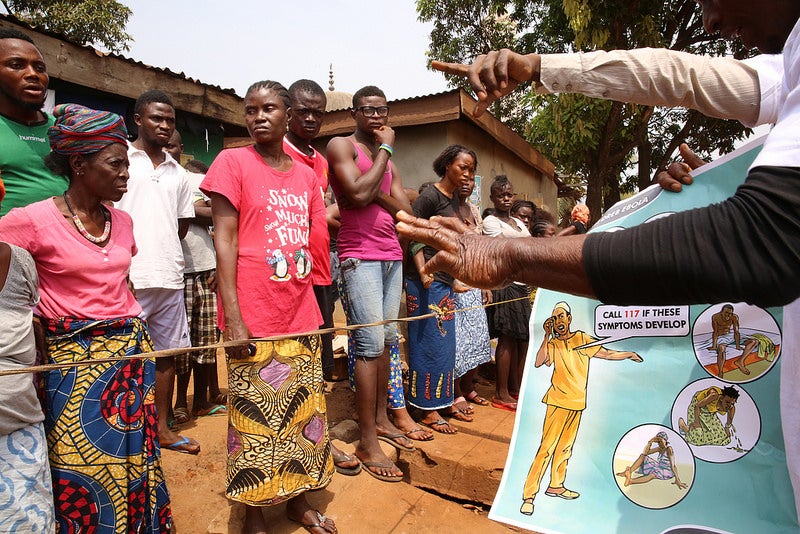
Risk management is a topic that conjures up mind-numbing images of log frames, badly rendered PowerPoint process diagrams, and “handbooks” that often run many hundreds of pages. Cast in this light, many tend to see risk management in narrow terms—as a box-checking exercise, a mere process to avoid a loss, or lowering the probability of a bad thing from occurring. A key takeaway from the recommendations of the UN-World Bank jointly published report, Pathways for Peace, is the urgent need to jettison this narrow managerial and technocratic view of risk management toward a more dynamic, sophisticated, and ambitious view of risk that ought to place it at the very core of how humanitarian and development practice can achieve better outcomes.
It is for this reason our input paper focused on advancing learning and awareness of the notion of multidimensional risks—the phenomena seen all too often in crisis settings, whereby risks in one domain can have impacts across different dimensions. When these risks interact, they produce a consequence greater than the sum of the individual risks.
But what does a multidimensional risk look like in practice? A rather classic case study on which our input paper focused was that of Sierra Leone before and after the 2014 Ebola crisis. There, vulnerability and exposure to pandemic risk, combined with weakness in the country’s health systems, economic risks, and post conflict fragility significantly increased the risk of relapsing into violent conflict. Even the outbreak of Ebola and its subsequent impacts cannot be properly understood by simply looking at health system vulnerabilities alone.
Years of conflict in Sierra Leone left the country highly fragile and its health systems very weak. The peacekeeping mission ended in 2014; corruption was endemic within national institutions; and the conflict had left a population with a deep-seated mistrust in the government and its institutions. Poor roads and lack of communication between rural areas and the urban capital of Freetown meant that many regions were isolated from the government.
Furthermore, violent conflict had destroyed the country’s health resources, records, and infrastructure. In post conflict Sierra Leone, these had never been restored; health capacity was so low that at the time of Ebola’s onset, just 16 percent of health facilities were operational, most of which were in Freetown. Underlining this, the country had only 12 ambulances with which to serve the entire population. Meanwhile, prior to the Ebola outbreak, Sierra Leone suffered an unexpected shock when international iron ore prices fell, from US$139.87 per metric ton in March 2013 to US$41 by December 2015. This shock sent iron ore revenues down, resulting in a subsequent loss of mining industry jobs, increased unemployment, and urban migration. This interruption of livelihoods can be closely linked to the outbreak itself. When normal subsistence and livelihood mechanisms are undermined, individuals are much more likely to turn to survival techniques such as the consumption of bush meat, thus increasing the risk of this particular transmission mechanism.
Lack of trust between citizens and the government severely hampered attempts to contain the subsequent risks. In districts in the north of the country that were quarantined in September 2014—Port Loko and Bombali—residents thought the government was exacting some sort of revenge on them because in the last election they had largely voted for the opposition. There was also a widespread and systematic outbreak of gender-based violence and incidents of rape in parts of the country. In some areas, teenage pregnancy rates rose by as much as 65 percent during the epidemic.
Thus, while it is naturally difficult to summarize the complexity of all the risks in the Sierra Leone context before and after Ebola, it offers a very clear example of why understanding health system issues, macro fiscal risks, or peacebuilding issues alone would not render a holistic picture of the multidimensional risk environment the country faced. Rather, the combination of these risks elevated the sum of the individual risks and posed a major challenge to postconflict stability. Problematically for development and humanitarian actors interviewed in the course of the background paper’s research, common awareness and understanding of these multidimensional risks and how they evolved were low. Unsurprisingly, much of the risk management practice was found to be fractured, siloed, or duplicative.
The types of societal stresses that struck Sierra Leone, and those that affect many other countries—such as geopolitical conflict, climate change, urbanization, overpopulation, increased migration, threats of pandemics, antibiotic resistance, new forms of economic volatility, and growing inequality—are certainly not new. What is new, however, are the system-level changes that are occurring in two fundamental respects: (1) these risks now exist in a state of greater interconnectedness; and (2) they are moving at a faster rate of change.
It is a brute fact that globalization increases interconnectedness at multiple levels between individuals, communities, and nations, as well as the rate of technological, economic, and social change. This in turn expands the size of the many systems that make up the global landscape, simultaneously increasing exposure to risks from previously unconnected parts and the potential negative impacts of shocks. Growing complexity also increases rates of change, decreasing the predictability of societal systems.
Understanding the pace of these changes and how they manifest as multidimensional risks is critical to taking practical steps to prevent conflict and build sustainable peace. Much of this has been indirectly recognized in the current UN reform processes, whether via the “new way of working,” in the recent “Peacebuilding and Sustaining Peace” report of the Secretary General, or in the logic behind “risk-informed development.” However, it also requires an ambitious reframing of risk beyond its box-checking connotations.



Join the Conversation